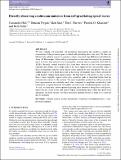Directly observing continuum emission from self-gravitating spiral waves
Abstract
We use a simple, self-consistent, self-gravitating semi-analytic disc model to conduct an examination of the parameter space in which self-gravitating discs may exist. We then use Monte Carlo radiative transfer to generate synthetic Atacama Large Millimeter/submillimeter Array (ALMA) images of these self-gravitating discs to determine the subset of this parameter space in which they generate non-axisymmetric structure that is potentially detectable by ALMA. Recently, several transition discs have been observed to have non-axisymmetric structure that extends out to large radii. It has been suggested that one possible origin of these asymmetries could be spiral density waves induced by disc self-gravity. We use our simple model to see if these discs exist in the region of parameter space where self-gravity could feasibly explain these spiral features. We find that for self-gravity to play a role in these systems typically requires a disc mass around an order of magnitude higher than the observed disc masses for the systems. The spiral amplitudes produced by self-gravity in the local approximation are relatively weak when compared to amplitudes produced by tidal interactions, or spirals launched at Lindblad resonances due to embedded planets in the disc. As such, we ultimately caution against diagnosing spiral features as being due to self-gravity, unless the disc exists in the very narrow region of parameter space where the spiral wave amplitudes are large enough to produce detectable features, but not so large as to cause the disc to fragment.
Citation
Hall , C , Forgan , D , Rice , K , Harries , T J , Klaassen , P D & Biller , B 2016 , ' Directly observing continuum emission from self-gravitating spiral waves ' , Monthly Notices of the Royal Astronomical Society , vol. 458 , no. 1 , pp. 306-318 . https://doi.org/10.1093/mnras/stw296
Publication
Monthly Notices of the Royal Astronomical Society
Status
Peer reviewed
ISSN
0035-8711Type
Journal article
Description
KR and BB gratefully acknowledge support from STFC grant ST/M001229/1. DF gratefully acknowledges support from the ECOGAL ERC advanced grant. Some calculations for this paper were performed on the University of Exeter Supercomputer, a DiRAC Facility jointly funded by STFC, the Large Facilities Capital fund of BIS, and the University of Exeter, and on the Complexity DiRAC Facility jointly funded by STFC and the Large Facilities Capital Fund of BIS. TJH acknowledges funding from Exeter’s STFC Consolidated Grant (ST/J001627/1).Collections
Items in the St Andrews Research Repository are protected by copyright, with all rights reserved, unless otherwise indicated.

